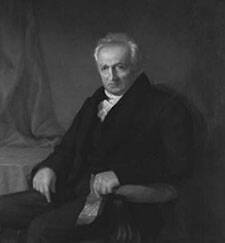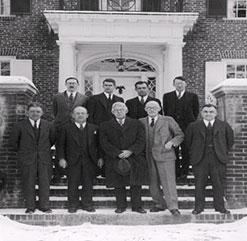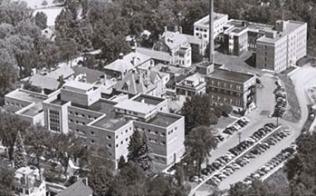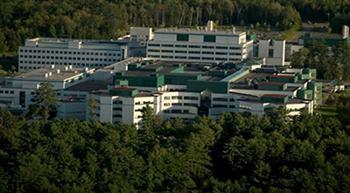The evolution of Dartmouth Hitchcock Medical Center and Dartmouth Hitchcock Clinics was comprised of many different ideas and collaborations coming together for a common purpose.
1797 – Dartmouth Medical School (DMS) founded
Originally called the Dartmouth Medical College, Dartmouth’s medical school was founded by Nathan Smith. It was the fourth medical school in the United States (preceded by schools at the University of Pennsylvania in 1765, Columbia in 1767, and Harvard in 1783). Noting the dearth of medical professionals in the rural Connecticut River Upper Valley area, Smith petitioned the Board of Trustees of Dartmouth College in August 1796 to fund the establishment of a medical school to train more physicians for the region. The board approved the request, and Smith began lecturing on November 22, 1797.
1890 – Dartmouth Hospital Association purchases land at the northern end of Hanover
Dr. Carlton P. Frost, Dean of Dartmouth Medical College, headed the newly formed Dartmouth Hospital Association, which purchased a small piece of land at the northern end of Hanover. He contacted his friend, the prosperous hotelier, Hiram Hitchcock, who embraced the prospect of building a small hospital in the area, a facility that would not only serve the sick but would also provide a place for the training of doctors and nurses.
1893 – Mary Hitchcock Memorial Hospital opens
The death of Mr. Hitchcock’s wife in 1887 prompted Hiram Hitchcock and Dr. Carlton P. Frost to move forward with their plan to build a small hospital. The new hospital was built in Hanover with funds donated by Mr. Hitchcock and dedicated as a memorial to Mary Maynard Hitchcock. The hospital continued to grow, and added several large additions between 1913 and the 1980s. Additional institutions also joined the complex, including the College infirmary, the Hitchcock Clinic physician group practice, and a nursing school.
1914 – Doctor of Medicine degree ends at Dartmouth Medical School
The Doctor of Medicine degree ended with the class of 1914 and for several decades thereafter, students attended DMS for two years before transferring to other schools where they received their formal medical degrees.
1927 – The Hitchcock Clinic partnership begins
The Hitchcock Clinic was one of the first organized group practices in the United States, certainly one of the first in New England. Medical practice in the 1920’s (and for decades to follow) was largely a private-practice or “solo” model. It was in this context, in June of 1927, that Dr. John Bowler, a surgeon practicing on Main Street in Hanover, proposed the idea of a multi-specialty group practice to four other Hanover physicians: Percy Bartlet, Harold Des-Brisay, Harry French, and John Gile. Together, they formed a partnership and petitioned the Mary Hitchcock Memorial Hospital (MHMH) Board of Trustees for exclusive rights to practice within the hospital. Three of the four had done their training at the Mayo Clinic in Rochester, MN, so in many ways the model of the Hitchcock Clinic was based on the Mayo Clinic model. The plan was approved by the MHMH Board of Trustees in 1927 and from that time onward, the members of the Hitchcock Clinic had, in effect, a sole franchise in practicing within the walls of the hospital.
1946 – The Hitchcock Clinic becomes incorporated under New Hampshire law
Initially, the Hitchcock Clinic group practice took the legal form of a partnership. Within the group practice, innovations were adopted without which the long-term success of the rural enterprise would have been compromised. In 1946, the original Hitchcock Clinic partnership was dissolved and the Clinic was incorporated under New Hampshire law as the Hitchcock Clinic, Inc.
1947 – Marianne Gaillard Faulkner donates $1 million to support a major expansion of Mary Hitchcock Memorial Hospital
Although many expansions to the hospital took place over the years, the most important addition came as a result of a generous gift from a Woodstock woman, Marianne Gaillard Faulkner. Her donation supported a major expansion of the hospital, then located on Maynard Street in Hanover, called the Faulkner House. Around 1970, the hospital doubled the height of Faulkner House by adding four floors. By that point, going vertical seemed the only way to expand, as six new medical school buildings over the next 10 years would close off the east for possible expansion.
1974 – Full 4-year Doctor of Medicine degrees resume at Dartmouth Medical School
The resumption of a full 4-year doctor of medicine degree resulted in part from the close alliance of the medical school with Mary Hitchcock Memorial Hospital and the Hitchcock Clinic, and their shared commitment to becoming an academic medical center through the formation of Dartmouth-Hitchcock Medical Center (DHMC).
1983 – The Hitchcock Clinic becomes a non-profit organization
In 1983, the clinic leaders voted to discard its formal for-profit corporate structure, dropping the “Inc.” from its name and becoming legally what it has always been in fact—a non-profit organization. At this time, it was recognized that without a financially strong hospital, the clinic could not attract and retain quality physician members. And without a strong medical staff, MHMH could not survive financially.
1991 – Mary Hitchcock Memorial moves to Lebanon
By the early 1980s, it had become increasingly clear that the physical plant of the medical center was inadequate, especially for the hospital and clinic but certainly for the medical school. The decisions made at that time set the stage for developing an academic medical center.
The original plan was to expand onto Dewey Field, north of the medical school, but with worry about the congestion and parking, this was rejected by the Town of Hanover. Dartmouth College, which had a long-term plan of expanding northward, offered DHMC a large portion of its Gile Tract on Route 120. The thirteen-acre building site was surrounded by about 200 acres of woodlands.
The “Lebanon Option” was agreed upon and planning began in 1985. Construction began in 1988 and was completed in 1991. The planning and design for the new DHMC was unique from the start. Corridors were wide and skylights were abundant to allow natural light to enter wherever possible. The move from the Hanover location to the Lebanon site took place on October 5, 1991.
1999 - Center for Shared Decision Making
The Center for Shared Decision Making opened in 1999 as the first center in the U.S. dedicated to encouraging doctors and patients to make decisions together. The provision of patient decision aids and support preparing around appointments services are now being provided by the Patient Support Corps.
2009 – Dartmouth-Hitchcock Health is formed
In 2009, the Dartmouth-Hitchcock Boards of Trustees approved the formation of an integrated health system designed to efficiently coordinate resources, expand access to the specialized services and research available at New Hampshire’s only academic medical center, and enhance the value and quality of care in communities throughout New Hampshire and eastern Vermont. The health system was formed through the creation of a “parent” corporation, Dartmouth-Hitchcock Health (D-HH), and originally had two provider members, Mary Hitchcock Memorial Hospital and the Dartmouth-Hitchcock Clinic, which includes community-based physician group practices in Concord, Keene, Manchester and Nashua.
During this period, clinic leadership promoted the development and growth of clinic group practices in Concord, Manchester, Nashua and Keene. Outreach programs continued as did programs in medically underserved areas. Additionally, through the creation of The Hitchcock Alliance, the Hospital created partnerships with other hospitals and provider organizations in the region to coordinate planning for the health needs of our region.
During this time, the clinic changed its name to the Dartmouth-Hitchcock Clinic, reflecting the growing partnership with the college. The Dartmouth-Hitchcock Clinic and MHMH subsequently integrated their governance, finances and operations, while maintaining separate corporate identities, to the advantage of the clinical enterprise and the medical school.
2013 to 2022: Continuing collaboration
To continue to thrive required a further change in the legal structure of the clinic and hospital to create greater efficiencies and to reflect the deep roots of collaboration and integration between the hospital and the clinic. It is in this context that the corporate bylaws of the clinic and hospital were amended in 2013 to create mirror bylaws for each entity, including mirror Boards of Trustees. While Dartmouth-Hitchcock Clinic and MHMH continued to maintain separate corporate identities, since 2013 they have operated in an even more integrated fashion.
Since 2013, 5 new provider affiliates joined the D-HH system: New London Hospital, Mt. Ascutney Hospital and Health Center, Cheshire Medical Center, Alice Peck Day Memorial Hospital, and the Visiting Nurse and Hospice of Vermont and New Hampshire.
The new system generates nearly $2 billion in revenues and is the largest private employer in the state of New Hampshire. As New Hampshire’s only academic medical system with the only Level 1 trauma center, the D-HH system is the largest provider of health care in the state and the second largest in Vermont. 24 Dartmouth-Hitchcock clinics provide ambulatory services across New Hampshire and Vermont. We serve more than 30 percent of the population of Manchester, 25 percent of the population in Nashua and 20 percent of the population of Concord. We care for 40 percent of the citizens of Vermont.
2022 to present: Dartmouth Health
In 2022, Dartmouth-Hitchcock Health rebranded as Dartmouth Health. The new name reflects the significant growth and interdependence of our health system and sets the stage for our future. Our new brand is part of our strategic plan to increase awareness of the Dartmouth Health academic health system and to reaffirm our position as the healthcare provider and employer of choice in our region, and our commitment to provide world-class care in the fabric of our communities.




